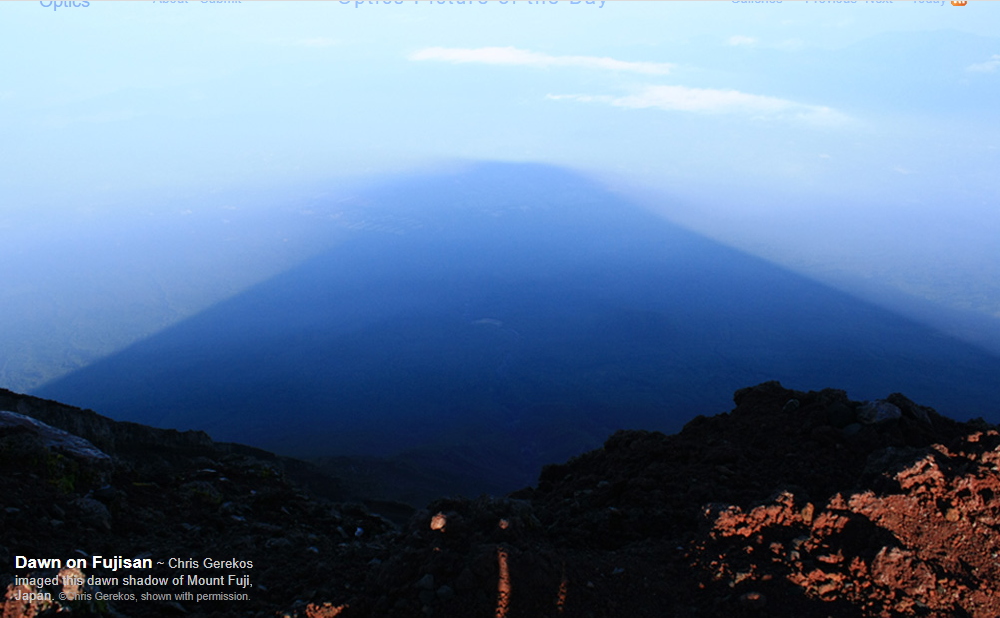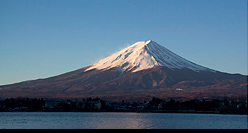Mount Fuji dawn shadow
Mount Fuji Dawn Shadow: A Spectacular Atmospheric Phenomenon
Mount Fuji, Japan's iconic volcanic mountain, is not only a sight to behold during the day but also offers a breathtaking spectacle during the early morning hours. As the sun begins to rise, casting its warm glow upon the landscape, an ethereal phenomenon known as the Mount Fuji dawn shadow emerges. This awe-inspiring event captivates the hearts of both locals and tourists alike, offering a unique perspective on the interplay between light and shadow in our atmosphere.
When ascending Mount Fuji in the darkness of night, visitors are rewarded with the opportunity to witness the sun's first rays illuminating the peak. Approximately thirty minutes after the ascent, as explorers embark on a walk around the crater, they are greeted by the captivating sight of Fujisan's shadow. Unlike the two-dimensional shadows we typically encounter on walls or the ground, this shadow takes on a three-dimensional form, appearing as a prism of unlit air suspended in the atmosphere.
The triangular profile of Mount Fuji contributes to the distinct shape of its shadow. While this particular mountain's shadow may not serve as a definitive example for all mountain shadows, it does illustrate an intriguing fact: regardless of their shapes, mountain shadows tend to exhibit triangular characteristics. This peculiar phenomenon can be attributed to the way sunlight interacts with the mountain's silhouette, resulting in a triangular projection that extends into the surrounding atmosphere.
As sunlight bathes the surrounding air, molecules, dust particles, and aerosols scatter light in various directions. Some of this scattered light reaches our eyes, creating a mesmerizing spectacle. The scattering of light gives rise to a phenomenon known as anticrepuscular rays, which appear to radiate from the antisolar point, marked by the tip of Mount Fuji's shadow. These rays add another layer of enchantment to the already captivating scene, further emphasizing the intricate interplay between light and shadow in our atmosphere.
The Mount Fuji dawn shadow is just one example of the mesmerizing atmospheric optics phenomena that can be observed around the world. Nature constantly surprises us with its ability to create breathtaking displays of light and shadow. Whether it's the iridescent colors of a rainbow, the shimmering glory of a sunset, or the ethereal glow of the Northern Lights, these phenomena serve as a reminder of the beauty and complexity of our natural world.
If you ever find yourself in Japan, a visit to Mount Fuji during the early morning hours is an experience not to be missed. Witnessing the emergence of the dawn shadow as the sun rises over this majestic mountain is a truly unforgettable sight. As the light dances across the landscape, casting its spellbinding spell, take a moment to appreciate the wonders of our atmosphere and the captivating phenomena it has to offer.
In conclusion, the Mount Fuji dawn shadow is a remarkable atmospheric phenomenon that showcases the interplay between light and shadow in our atmosphere. With its triangular shape and the scattering of light by molecules, dust particles, and aerosols, this shadow captivates observers with its three-dimensional form. Furthermore, the presence of anticrepuscular rays adds an extra layer of enchantment to this already mesmerizing spectacle. As we marvel at the beauty of the Mount Fuji dawn shadow, we are reminded of the incredible wonders that nature has in store for us, if only we take the time to look up and appreciate them.

Dawn on Fujisan ~ Chris Gerekos imaged this dawn shadow of Mount Fuji, Japan. ©Chris Gerekos, shown with permission.
"As the tradition wants, I climbed it during the night to see the sun rising at the top of the mountain. So about 30 minutes later, I had a walk around the crater, where I could see Fujisan's shadow."
The shadow is 3D unlike 2D ones on walls or the ground. It is a prism of unlit air. The surrounding air is in sunlight and molecules, dust and aerosol scatter light backwards to the camera. Fujisan is roughly triangular in profile and so it is not a good test to demonstrate that, regardless of their shapes, all mountain shadows are triangular. But they are.
There are hints of anticrepuscular rays radiating from the antisolar point marked by the shadow's tip.

Note: this article has been automatically converted from the old site and may not appear as intended. You can find the original article here.
Reference Atmospheric Optics
If you use any of the definitions, information, or data presented on Atmospheric Optics, please copy the link or reference below to properly credit us as the reference source. Thank you!
-
<a href="https://atoptics.co.uk/blog/mount-fuji-dawn-shadow/">Mount Fuji dawn shadow</a>
-
"Mount Fuji dawn shadow". Atmospheric Optics. Accessed on April 19, 2024. https://atoptics.co.uk/blog/mount-fuji-dawn-shadow/.
-
"Mount Fuji dawn shadow". Atmospheric Optics, https://atoptics.co.uk/blog/mount-fuji-dawn-shadow/. Accessed 19 April, 2024
-
Mount Fuji dawn shadow. Atmospheric Optics. Retrieved from https://atoptics.co.uk/blog/mount-fuji-dawn-shadow/.